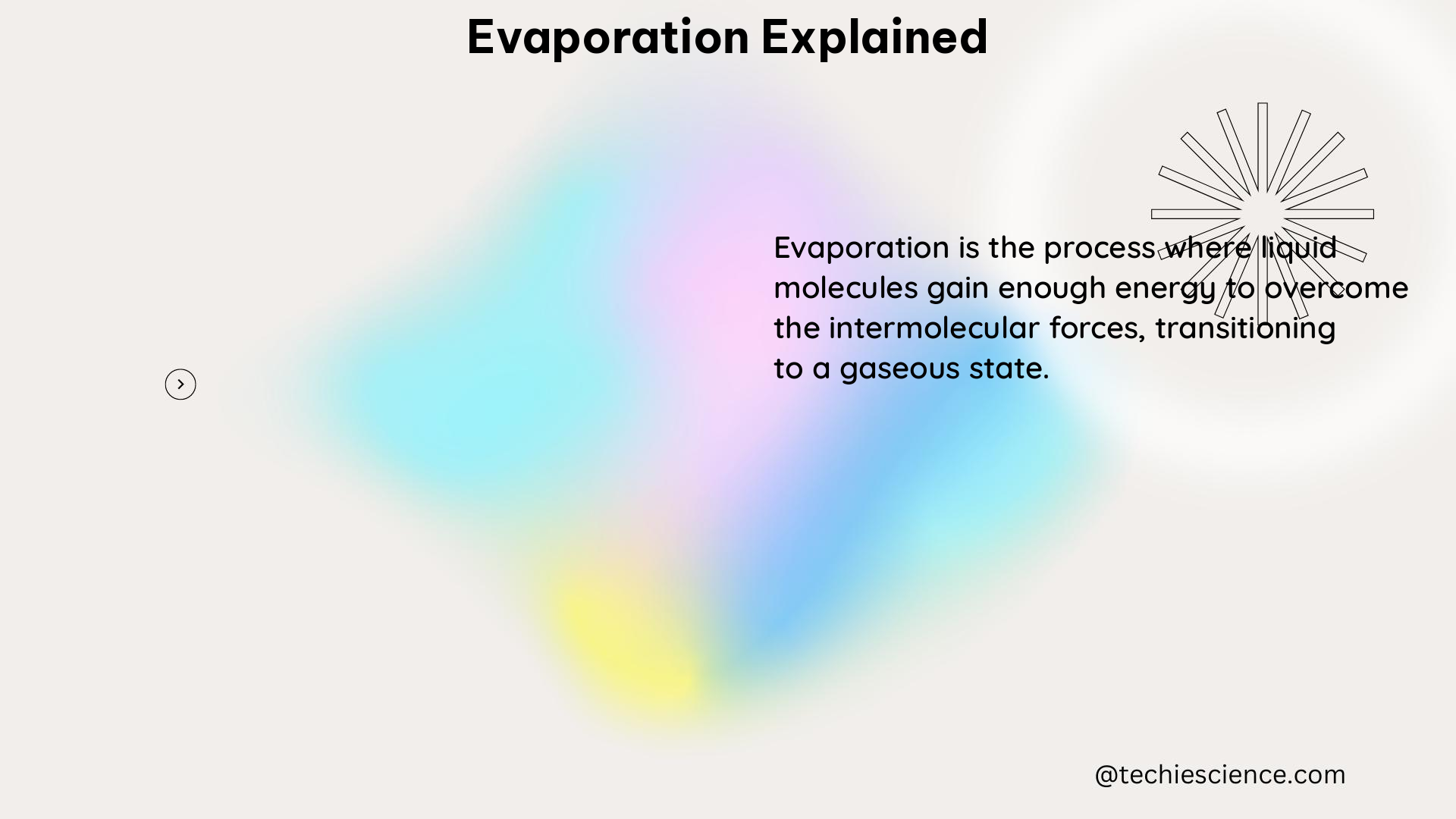Evaporation is a fundamental physical process that plays a crucial role in the Earth’s water cycle, as well as in various industrial and agricultural applications. This comprehensive guide delves into the intricate details of evaporation, providing science students with a deep understanding of the underlying principles, quantifiable data, and practical applications.
The Fundamentals of Evaporation
Evaporation is the transformation of a liquid, such as water, into a gas, known as water vapor. This process is driven by the kinetic energy of the liquid molecules, which overcomes the intermolecular forces that hold them together in the liquid state. As the liquid molecules gain enough energy, they can escape the liquid surface and enter the gaseous phase.
The rate of evaporation is influenced by several key factors:
- Temperature: The higher the temperature, the greater the kinetic energy of the liquid molecules, leading to a faster evaporation rate.
- Humidity: The lower the humidity, the greater the capacity of the surrounding air to absorb the water vapor, resulting in a higher evaporation rate.
- Wind Speed: Stronger winds help to remove the water vapor from the liquid surface, increasing the evaporation rate.
- Solar Radiation: The more solar energy absorbed by the liquid surface, the higher the temperature and the faster the evaporation rate.
Quantifying Evaporation Rates

The rate of evaporation can be measured and expressed in various units, depending on the specific application and context:
- Millimeters per Day (mm/day): This unit is commonly used to measure the evaporation from water bodies, such as lakes, reservoirs, and ponds.
- Grams per Square Meter per Hour (g/m²/h): This unit is often used in industrial and agricultural settings to quantify the evaporation from surfaces, such as soil or plant leaves.
- Pounds per Hour (lb/h): This unit is typically used in industrial applications, such as cooling towers and power plants, to measure the rate of water evaporation.
Measurement Techniques
Several methods are used to measure evaporation rates:
- Class A Pan: A standardized evaporation pan used in meteorology to measure the evaporation from a water surface. The water level in the pan is monitored, and the change in water depth over time is used to calculate the evaporation rate.
- Penman Equation: A mathematical model that takes into account various meteorological factors, such as temperature, humidity, wind speed, and solar radiation, to estimate the evaporation rate from a water surface.
- Lysimeters: Specialized instruments that measure the actual evapotranspiration (the combined process of evaporation and transpiration) from a specific surface, such as soil or vegetation.
Factors Affecting Evaporation Rates
In addition to the primary factors of temperature, humidity, wind speed, and solar radiation, there are several other factors that can influence the rate of evaporation:
- Surface Area: The larger the surface area of the liquid, the greater the rate of evaporation.
- Liquid Composition: The presence of dissolved solutes in the liquid can affect the evaporation rate, as they can alter the vapor pressure of the liquid.
- Atmospheric Pressure: Lower atmospheric pressure, such as at higher elevations, can lead to a higher evaporation rate.
- Turbulence: Increased turbulence near the liquid surface can enhance the rate of evaporation by promoting the removal of water vapor.
Anthropogenic Factors and Evaporation
Human activities can also significantly impact evaporation rates:
- Irrigation: The application of water for agricultural purposes can increase the overall evaporation from the land surface.
- Industrial Cooling: Processes such as power generation and industrial manufacturing often involve the use of water for cooling, leading to increased evaporation.
- Urban Environments: The presence of buildings, roads, and other impervious surfaces in urban areas can alter the local microclimate and affect evaporation rates.
- Human Perspiration and Respiration: The water vapor released through human perspiration and respiration can contribute to the overall evaporation in densely populated areas, as demonstrated by a study using a hybrid deep learning model.
Practical Applications of Evaporation
Understanding the principles and quantification of evaporation is crucial for various applications:
- Irrigation Management: Accurate estimation of evaporation rates is essential for optimizing water usage in agricultural systems and improving crop yields.
- Industrial Cooling: Evaporation plays a crucial role in the design and operation of cooling systems, such as those used in power plants and manufacturing facilities.
- Water Resource Management: Monitoring and predicting evaporation rates from water bodies is essential for managing water supplies and addressing issues related to water scarcity.
- Climate and Weather Modeling: Evaporation is a key component in the Earth’s water cycle and plays a significant role in climate and weather patterns.
Conclusion
Evaporation is a complex and multifaceted process that is fundamental to various scientific disciplines, including physics, chemistry, and meteorology. This comprehensive guide has provided science students with a deep understanding of the underlying principles, quantifiable data, and practical applications of evaporation. By mastering the concepts presented here, students will be well-equipped to tackle real-world challenges and contribute to the advancement of scientific knowledge.
References
- Methods for the quantification of evaporation from lakes, https://nora.nerc.ac.uk/id/eprint/14359/1/wmoevap_271008.pdf
- The Considerable Water Evaporation Induced by Human Perspiration and Respiration in Megacities: Quantifying Method and Case Study in Beijing, https://www.ncbi.nlm.nih.gov/pmc/articles/PMC9324489/
- Basics of Evaporation and Evapotranspiration, https://cales.arizona.edu/azmet/etowhat1.pdf
- Evaporation of Water and Ethanol (with Thermal Imaging Camera), https://physicsexperiments.eu/1941/evaporation-of-water-and-ethanol-%28with-thermal-imaging-camera%29
- Rate of Evaporation – an overview, https://www.sciencedirect.com/topics/chemistry/rate-of-evaporation

The lambdageeks.com Core SME Team is a group of experienced subject matter experts from diverse scientific and technical fields including Physics, Chemistry, Technology,Electronics & Electrical Engineering, Automotive, Mechanical Engineering. Our team collaborates to create high-quality, well-researched articles on a wide range of science and technology topics for the lambdageeks.com website.
All Our Senior SME are having more than 7 Years of experience in the respective fields . They are either Working Industry Professionals or assocaited With different Universities. Refer Our Authors Page to get to know About our Core SMEs.